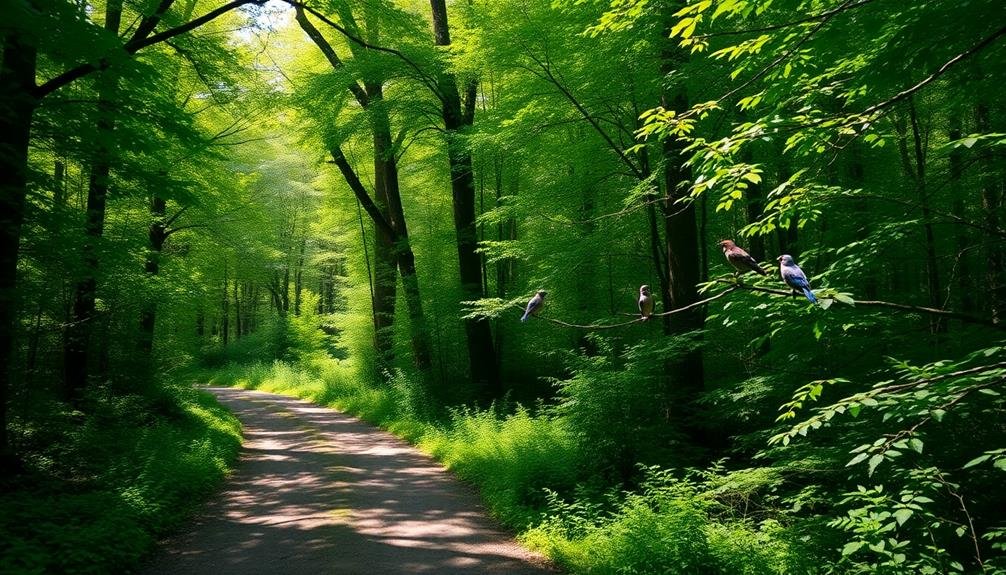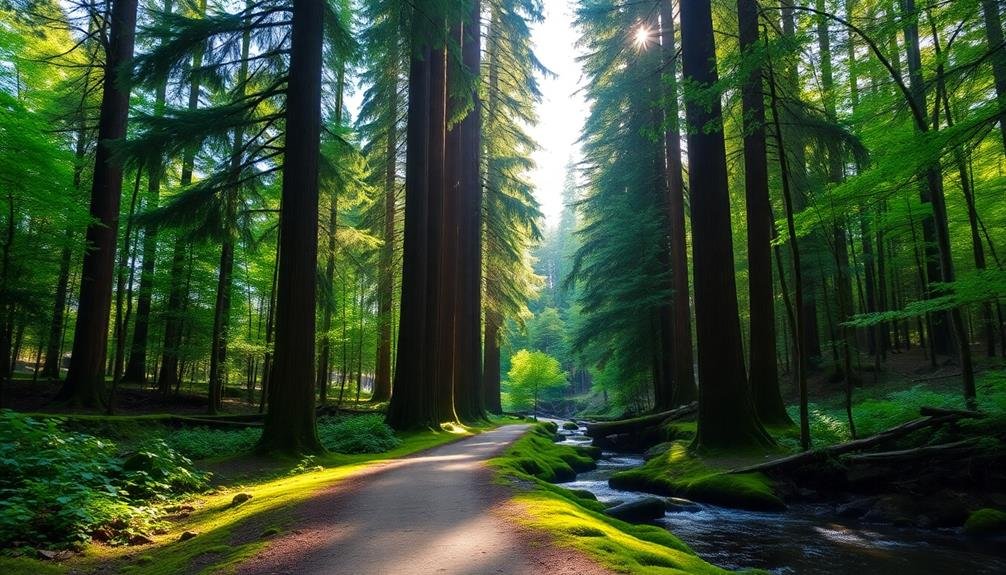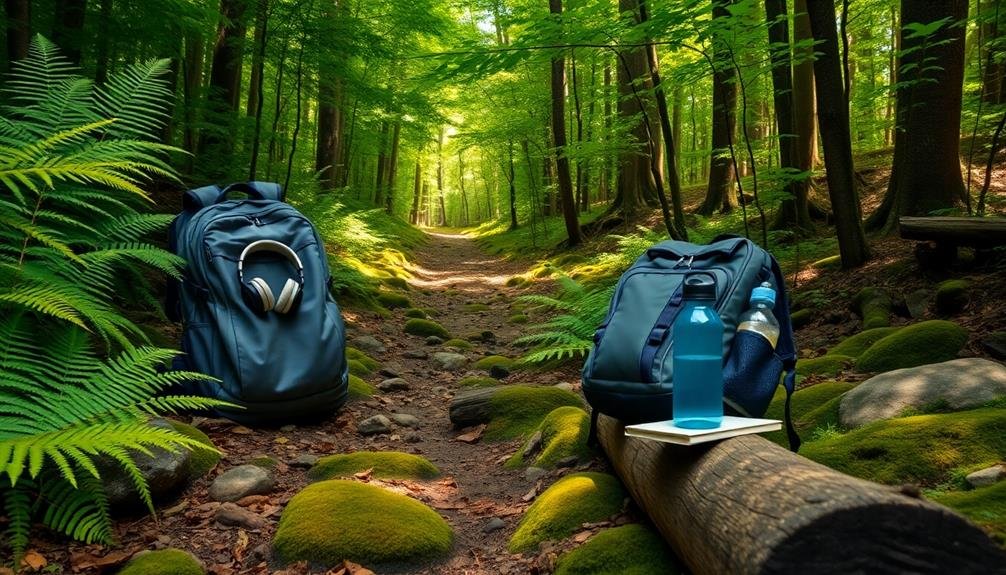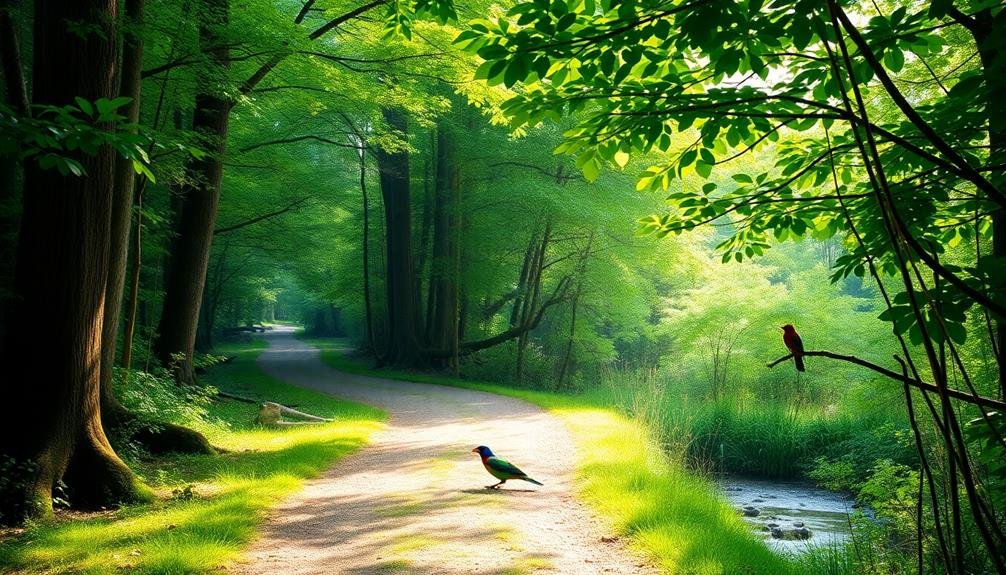To create calming nature sound walks, start by choosing serene locations free from urban noise. Opt for early mornings or after rainfall for crisp sounds. Equip yourself with comfortable shoes, hydration, and a portable recorder to capture the ambient noise. As you walk, focus on subtle sounds like rustling leaves and birdsong, practicing deep breathing to enhance mindfulness. Engage all your senses and document your feelings and sounds. Regularly scheduling these walks can deepen your connection to nature. There's more to discover, including tips for enhancing your experience and sharing it with others.
Understanding Nature Sound Walks

When you set out on a nature sound walk, you're immersing yourself in the soothing symphony of the outdoors. This experience isn't just about being in nature; it's about tuning into the subtle sounds that surround you. As you walk, pay attention to the rustling leaves, chirping birds, and the gentle flow of water. Each sound contributes to a unique auditory landscape, inviting you to become more aware of your environment.
Nature sound walks encourage mindfulness, letting you focus on the present moment. Instead of getting lost in thoughts, you train your ears to capture the intricate details of your surroundings. You might notice the way the wind whispers through the trees or how a distant waterfall creates a rhythmic backdrop. It's an opportunity to engage your senses fully, fostering a deeper connection with nature.
As you explore, consider varying your routes. Different locations offer distinct sounds, enriching your experience. Whether you're in a dense forest, a tranquil park, or along a winding river, each step reveals new auditory treasures.
Embrace the journey, and let the sounds guide you to a place of calm and awareness in the heart of nature.
Benefits for Anxiety Relief
When you take a nature sound walk, you'll notice a significant reduction in stress hormones, helping you feel more at ease.
This experience also enhances your mindfulness practice, allowing you to fully engage with your surroundings.
Reduces Stress Hormones
Calmness often eludes us in our fast-paced lives, but immersing yourself in nature sound walks can greatly reduce stress hormones like cortisol. When you step into a serene environment filled with the sounds of rustling leaves, chirping birds, and flowing water, your body responds positively.
These natural sounds signal your brain to relax, creating a soothing atmosphere that helps lower your stress levels. As you walk, your attention shifts from daily worries to the rhythm of nature. This shift not only lifts your mood but also plays a vital role in regulating your body's stress response.
Studies show that spending time in nature can lead to significant drops in cortisol levels, which is key to managing anxiety and promoting overall well-being. Incorporating nature sound walks into your routine provides you with a simple yet effective way to combat stress.
Just a short walk can help you feel more centered and balanced. So, the next time you feel overwhelmed, consider taking a break to immerse yourself in nature's symphony. You'll find that even a brief escape can leave you refreshed and better equipped to handle life's challenges.
Enhances Mindfulness Practice
Experiencing the calming effects of nature sound walks not only reduces stress but also enhances your mindfulness practice, offering significant benefits for anxiety relief. When you immerse yourself in the soothing sounds of rustling leaves, chirping birds, and flowing water, you create a sensory environment that encourages present-moment awareness.
This connection to nature helps ground you, allowing you to focus on your breath and sensations, rather than racing thoughts. As you walk, pay attention to the sounds around you; let them anchor your mind. Notice how the gentle rhythm of nature can slow down your racing heart and ease your worries.
This focused attention cultivates mindfulness, shifting your awareness away from anxiety and toward tranquility. Your body responds positively, and you may find that your anxiety symptoms diminish as you engage fully with your surroundings.
Incorporating these nature sound walks into your routine can be a powerful tool for managing anxiety. By fostering a deeper connection to the present moment, you empower yourself to navigate life's challenges with greater ease.
Embrace these calming experiences, and you'll likely notice a significant improvement in your overall well-being.
Choosing the Right Location

When choosing the right location for your calming nature sound walk, consider its proximity to natural settings that inspire tranquility.
Make certain the area is accessible and safe, so you can fully immerse yourself in the experience without distractions.
A well-chosen spot can greatly enhance the soothing effects of your walk.
Proximity to Nature
The right location can greatly enhance your nature sound walk, offering a rich tapestry of auditory experiences. To immerse yourself in calming sounds, seek out areas with diverse ecosystems. Forests, wetlands, or coastal regions often provide a symphony of bird calls, rustling leaves, and flowing water.
Look for spots where these elements intersect; the combination can create a more varied soundscape. Consider how close you're to urban areas. You want to minimize noise pollution, so aim for places that feel remote yet are still accessible. Parks and nature reserves can be ideal, as they often balance proximity to nature with fewer distractions.
When choosing your location, pay attention to the time of day; certain sounds, like morning birdsong or evening crickets, can enhance your experience. Also, think about seasonality. Different times of year bring unique sounds, from the chirping of cicadas in summer to the crunch of leaves in autumn.
Accessibility and Safety
Choosing a location for your nature sound walk goes beyond just finding a serene spot; it's crucial to evaluate accessibility and safety.
First, consider how easily you and your participants can reach the site. Are there well-maintained paths? Is parking available? If you're bringing people with mobility challenges, make certain the terrain is suitable, with minimal obstacles and gentle slopes.
Next, think about safety. Look for areas away from busy roads, steep drop-offs, or potential hazards like unstable ground. Check the weather conditions, too; make certain you're not heading into areas prone to flooding or extreme weather.
It's also wise to scout the location beforehand to identify potential risks and make certain a peaceful environment.
Lastly, consider how crowded the area might be. A popular spot can lead to distractions, while remote locations might feel isolating. Aim for a balance that encourages relaxation but doesn't compromise safety.
Timing Your Walks
Finding the right time for your nature sound walk can greatly enhance the experience.
Whether you seek tranquility or vibrant sounds, timing plays a vital role.
Consider these moments for your walks:
- Early morning: Feel the crisp air and listen to the gentle rustling of leaves as birds greet the dawn.
- Midday: Embrace the warm sun, and enjoy the lively sounds of insects buzzing and leaves fluttering in the breeze.
- Late afternoon: Witness the golden hour, where the light softens and the calls of wildlife become richer.
- Dusk: Experience the shift into night, as crickets chirp and the world settles into a soothing silence.
- After rain: Revel in the fresh scent of wet earth and the calming sound of raindrops dripping from leaves.
Essential Gear and Preparation

While you gear up for your nature sound walk, having the right equipment can make all the difference in your experience. Start with comfortable shoes that provide good support. You'll be walking for a while, so you want to avoid blisters or sore feet.
Next, consider a lightweight backpack to carry your essentials. Pack a water bottle to stay hydrated and snacks to keep your energy up. A notebook or journal is handy for jotting down your thoughts or observations, enhancing your connection with the environment.
Don't forget your audio gear. A pair of quality headphones will help you immerse yourself in the sounds of nature, while a portable recorder can capture those soothing sounds for later enjoyment. If you're planning to record, make sure you have extra batteries and memory cards.
Lastly, check the weather forecast and dress appropriately. Layer your clothing to adjust to changing temperatures, and bring a light rain jacket if there's a chance of rain.
With the right gear and preparation, you'll be set to fully embrace the calming benefits of your nature sound walk.
Mindfulness Techniques to Use
As you commence on your nature sound walk, consider incorporating mindfulness techniques to enhance your experience.
Deep breathing exercises can help you center yourself, while grounding techniques connect you to the earth beneath your feet.
Focused listening practices will sharpen your awareness of the soothing sounds around you, allowing you to fully immerse in the moment.
Deep Breathing Exercises
Deep breathing exercises can instantly ground you and enhance your connection to nature during a sound walk. When you take a moment to focus on your breath, you allow the soothing sounds around you to sink in.
Here's how to incorporate deep breathing into your experience:
- Inhale deeply through your nose, filling your lungs with the fresh scent of pine and earth.
- Hold your breath for a moment, feeling the stillness envelop you like a gentle hug.
- Exhale slowly through your mouth, releasing tension as you listen to the rustle of leaves and distant bird songs.
- Repeat this process, imagining the air flowing in and out like gentle waves lapping at the shore.
- Visualize the colors of nature—vibrant greens and deep blues—as you breathe, connecting your breath to the rhythm of the natural world.
Grounding Techniques
During your sound walk, grounding techniques can help anchor you in the present moment, enhancing your experience of nature's calming effects.
One effective method is to focus on your senses. As you walk, take a moment to notice the texture of the ground beneath your feet—feel the grass, dirt, or gravel. Pay attention to how it feels and the sensations it brings.
Next, engage your sense of sight. Look around and observe the colors, shapes, and movements in nature. Notice the play of light through the leaves or the way the clouds drift across the sky.
Another technique is to practice mindful breathing. Each time you inhale, imagine drawing in the peaceful energy of your surroundings. With each exhale, let go of any tension or distractions.
You can also use your sense of smell. Take a deep breath and inhale the fresh, earthy scents around you. Whether it's flowers, pine, or damp soil, let these aromas ground you further in the moment.
Focused Listening Practices
Focused listening practices transform your sound walk into a rich, immersive experience. By honing in on the sounds around you, you deepen your connection to nature and enhance your mindfulness.
Here are some techniques to enrich your focused listening:
- Identify distinct sounds: Notice the rustle of leaves, the chirping of birds, or the distant trickle of water.
- Follow sound sources: Allow your ears to guide you. Is that a gentle breeze or a busy squirrel?
- Scan your environment: Shift your focus between close and distant sounds. What's in the foreground? What's hidden in the background?
- Pause and reflect: Periodically stop walking to absorb the symphony of sounds, letting them wash over you.
- Breathe and synchronize: Coordinate your breath with the rhythm of nature, inhaling deeply as you listen to a gentle stream.
These practices help you engage with your surroundings on a deeper level. The more you listen, the more you'll discover the intricate sounds that make your natural environment unique and soothing.
Embrace this auditory exploration, and let it guide your journey towards tranquility.
Incorporating Soundscapes

Incorporating soundscapes into your nature sound walks can enhance the overall experience, creating a more immersive environment. By integrating sounds that reflect the natural surroundings, you deepen your connection to the space. Begin by identifying the unique sounds of the area—birds chirping, leaves rustling, or water flowing. These elements serve as a foundation for your soundscape.
Next, consider layering additional sounds. You might bring along a portable speaker or even use your phone to play recordings of soothing nature sounds. Just be mindful of volume levels to avoid disturbing other nature enthusiasts or wildlife. Aim for a balance that complements the natural sounds rather than overpowering them.
You can also experiment with different times of day. Early morning might offer a symphony of birds, while evening may provide a tranquil backdrop of crickets and gentle breezes.
Encourage participants to close their eyes for a moment, allowing the soundscape to envelop them and foster relaxation.
Engaging Your Senses
Engaging your senses is essential for creating a truly immersive nature sound walk. When you step into the natural world, you want to absorb every sight, sound, and scent around you. This heightened awareness helps deepen your connection to nature and enhances the calming effects of your walk.
Here are some ways to engage your senses:
- Listen to the gentle rustle of leaves swaying in the breeze.
- Smell the earthy aroma of damp soil after a recent rain.
- Feel the coolness of moss under your fingertips as you explore.
- Observe the vibrant colors of wildflowers popping against the green backdrop.
- Taste the crisp air, invigorating and rejuvenating as you breathe deeply.
As you focus on these sensory experiences, you'll find that each element of nature adds to the overall tranquility of your walk.
Allow yourself to get lost in the symphony of sounds and sights, letting them wash over you. By actively engaging your senses, you transform a simple stroll into a rich, calming journey that nurtures your mind and spirit.
Documenting Your Experiences

As you wander through nature, capturing your experiences can deepen your appreciation of the serene environment around you. Take a moment to pause and observe your surroundings. Use a journal to jot down your thoughts, feelings, and any significant moments that resonate with you. Describe the sounds—like the rustling leaves or chirping birds—that bring the scene to life.
Consider recording audio notes on your phone. This way, you can capture the ambient sounds that make your walk unique. Later, these recordings can transport you back to that tranquil moment.
If you're inclined, snap some photographs, focusing on the intricate details of nature, like the textures of tree bark or the colors of flowers. These visuals can complement your written reflections.
Don't forget to engage with your emotions throughout the process. What did you feel when the sunlight filtered through the branches? Documenting these sensations can enhance your connection to nature.
Sharing Your Walks With Others
While you relish the tranquility of your nature sound walks, sharing your experiences with others can amplify that sense of connection.
Inviting friends or family to join you creates an enriching environment where everyone can appreciate the soothing sounds of nature together. Plus, discussing your walks can inspire others to commence on their own calming journeys.
Here are some ways to share your nature sound walks:
- Organize a group walk: Bring together a small group and explore a local park or trail.
- Start a social media challenge: Share your favorite sounds and encourage others to post their experiences.
- Create a shared playlist: Compile your favorite nature sounds, allowing others to enjoy them even when they can't be outside.
- Host a nature sound evening: Invite friends over to listen to recordings while enjoying calming snacks and conversation.
- Write a blog or journal: Document your experiences and reflections, inviting feedback from readers.
Tips for Consistency

To maintain consistency in your nature sound walks, setting a regular schedule can make all the difference. Whether you choose to walk every morning or on weekends, sticking to a routine helps you prioritize this calming practice.
Next, pick a specific location for your walks. Familiar surroundings allow you to notice subtle changes in sound and environment, enhancing your experience. You might also consider varying your route occasionally to keep things fresh without losing that sense of familiarity.
Don't forget to prepare your mind and body before each walk. A quick moment of mindfulness or deep breathing can help you focus on the sounds of nature, making each walk more enriching.
Additionally, keep a journal to track your experiences. Documenting your thoughts and feelings after each walk can reinforce your commitment and help you reflect on your connection with nature.
Lastly, invite a friend or family member to join you. Sharing the experience can motivate you to stick with your plans and deepen your appreciation for the calming effects of nature sounds.
Frequently Asked Questions
What Types of Nature Sounds Are Most Calming?
You'll find that gentle rain, rustling leaves, and distant waves are among the most calming nature sounds. Birds chirping softly and a flowing stream can also soothe your mind and help you relax.
Can I Do Sound Walks in Urban Areas?
Absolutely, you can do sound walks in urban areas! Just find parks, quiet streets, or green spaces. Listen for birds, rustling leaves, or distant chatter—embracing these sounds can offer a rejuvenating break from the city.
How Long Should a Nature Sound Walk Last?
A nature sound walk should ideally last between 30 minutes to an hour. This gives you enough time to immerse yourself in the environment, enjoy the sounds, and experience a sense of calm and relaxation.
What Should I Do if I Encounter Wildlife?
If you encounter wildlife, stay calm and keep your distance. Observe quietly without startling them. Don't feed or approach; instead, enjoy the moment and appreciate the beauty of nature. Always respect their space and habitat.
Are There Specific Times of Year for Optimal Sound Walks?
You'll find ideal times for sound walks vary by location, but spring and early autumn generally offer rich sounds. Avoid peak summer heat and winter's cold; nature's symphony thrives in moderate temperatures and gentle breezes.
In Summary
Creating calming nature sound walks can transform your well-being and help you connect with the world around you. By understanding the benefits, choosing the right location, and engaging your senses, you'll find peace and relief from anxiety. Remember to document your experiences and share them with others to inspire connections. With consistency, these walks can become a cherished part of your routine, bringing tranquility and joy to your life. So, lace up your shoes and step into nature's embrace!





Leave a Reply